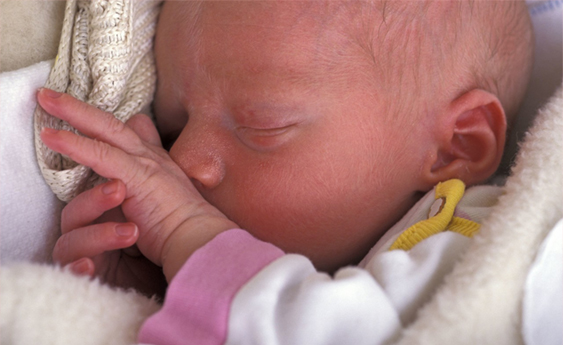BREASTFEEDING
Do You Act Properly When Baby Has Breast Milk Jaundice?
Breast milk jaundice is divided into late-onset breast milk jaundice and early-onset breast milk jaundice (breastfeeding jaundice). With the current increase in breastfeeding rates, the incidence of breast milk jaundice may reach 20% to 30% [1], which has become one of the types of jaundice that cannot be ignored.
Increased Enterohepatic Circulation May be Main Cause of Breast Milk Jaundice
Early-onset breast milk jaundice usually occurs 3 to 4 days after the birth of a child, and the peak value of bilirubin will exceed the average value of physiological jaundice. There are two possible influencing factors [2-3]: insufficient breastfeeding, decreased intestinal motility, which makes it difficult to excrete bilirubin, and β-glucuronidase activity in colostrums increase. The combination of the two will increase liver-intestinal circulation and increase serum bilirubin levels. while high serum bilirubin will further reduce infant appetite and sucking efficiency and reduce serum bilirubin excretion in meconium.
With respect to the mechanism of late-onset breast milk jaundice, currently only two conjectures[2] are proposed: The first conjecture is that the rich β-glucuronidase in breast milk breaks down the bilirubin-gluconate chain and make serum bilirubin rise, which in turn lead to increased intestinal circulation and jaundice. The second conjecture states that the occurrence of late-onset breast milk jaundice may be related to the inhibition of transcription gene UGT1A1 of UDPGT in breast milk by substances. This enzyme has a low content of synthetic raw materials (proteins) in newborns. After being inhibited, the conversion efficiency of unbound bilirubin to bound bilirubin will be reduced, and more unbound bilirubin will be absorbed into the blood, thus causing jaundice.
Studies have shown [4] that even after cession of breastfeeding, bilirubin levels will not reach their original high values even upon resuming breastfeeding. Therefore, in the early clinical period, pausing breast milk has been the main method for treating breast milk jaundice. However, more and more studies nowadays find that the method of “one size fits all” by stopping of breastfeeding is not a good choice.
Cession of Breastfeeding Depends on Circumstances, the Principle is Continue
Studies have found that [5], artificial feeding is not as good as breast milk and breast milk + formula in terms of jaundice or neonatal development. So for early-onset breast milk jaundice, breast milk cannot be stopped, on the contrary, it should be increased. If the serum bilirubin is greater than 256.5 μmol/L (15mg/dl) or there are other high risk factors within 1 week after birth, intermittent phototherapy can be considered, but breastfeeding is still recommended [6].
Whether late-onset breast milk jaundice is suspended or not depends on infant bilirubin [6]. In case of serum bilirubin <256.5μmol/L (15mg / dl), it should continue breastfeeding and monitor bilirubin; while serum bilirubin> 256.5 ~ 342.0μmol/L (15-20mg/dl), breastfeeding can be suspended for three days, replacing with formula, then continuing breastfeeding when bilirubin drops by 30% to 50%; when serum bilirubin> 342.0μmol/L (20mg/dl), in addition to suspending breast milk, you may also combine phototherapy, breastfeeding should also be continued after the reduction of bilirubin.
The incidence of breast milk jaundice is highly individualized. Although most patients have a good prognosis, controlling bilirubin levels as soon as possible is still the key. In addition to breast milk, phototherapy and other intervention methods, the probiotics of the intestines in popular now has adjuvant treatment for breast milk jaundice. Studies have found that [7], the micro-ecological preparation Mamiai can promote the intestinal motility of the newborn, increase the excretion of bilirubin in the intestine, reduce the enterohepatic circulation, and thereby reduce the total serum bilirubin of the newborn, so it can be used as an option for treating breast milk jaundice.
References
[1] Zhang Xianghua, Li Jinhu. Experience in Treatment of 52 Cases of Breast Milk Jaundice [J]. Public Medical Forum Magazine, 2009, 13 (32): 981-982
[2] Song Chao, Jin Ke. Research Progress on Breastfeeding Jaundice and Related Factors [J]. Shandong Medical Journal, 2013, 53 (22): 85-87
[3] Cao Yuping. Clinical Analysis of 51 Cases of Early-Onset Breast Milk Jaundice [J]. Chinese Journal of Birth Health & Heredity, 2001, 9 (5): 89-89
[4] Xu Zhizhi. The Etiology, Pathogenesis and Prevention of Breast Milk Jaundice [J]. Chinese Journal of Practical Pediatrics, 1999 (2): 68-70
[5] Zhu Yunxia, Li Yongpei, Lin Xiaoyan. Effects of Different Feeding Methods on Serum Bilirubin in Children with Early-Onset Breast Milk Jaundice [J]. Zhejiang Journal of Integrated Traditional Chinese and Western Medicine, 2019, 29 (02): 53-55
[6] Wang Danhua. Breastfeeding Guidance for Infant Jaundice [J]. Chinese Journal of General Practitioners, 2014, 13 (1): 11-12
[7] Huang Zhihua. Journal of Neonatal. 2002, 17 (4): 150-2
